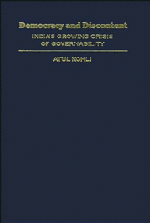Book contents
- Frontmatter
- Contents
- List of tables and figures
- Preface and acknowledgments
- PART I INTRODUCTION
- PART II THE GROWING PROBLEMS OF GOVERNING THE PERIPHERY: POLITICS IN THE DISTRICTS
- PART III ORDER AND BREAKDOWN IN THE STATES
- PART IV CENTRALIZATION AND POWERLESSNESS AT THE CENTER
- Introduction: the Center
- 11 Managing the economy: halfhearted liberalization
- 12 Managing the troubled political institutions: the Congress party and relations with Punjab
- Conclusion: the Center
- PART V FINAL INFERENCES
- Bibliography
- Index
11 - Managing the economy: halfhearted liberalization
Published online by Cambridge University Press: 05 June 2012
- Frontmatter
- Contents
- List of tables and figures
- Preface and acknowledgments
- PART I INTRODUCTION
- PART II THE GROWING PROBLEMS OF GOVERNING THE PERIPHERY: POLITICS IN THE DISTRICTS
- PART III ORDER AND BREAKDOWN IN THE STATES
- PART IV CENTRALIZATION AND POWERLESSNESS AT THE CENTER
- Introduction: the Center
- 11 Managing the economy: halfhearted liberalization
- 12 Managing the troubled political institutions: the Congress party and relations with Punjab
- Conclusion: the Center
- PART V FINAL INFERENCES
- Bibliography
- Index
Summary
Over the past decade, India's leaders have sought to liberalize their country's relatively controlled and closed economy. The initial steps in that direction were taken by the Janata government during 1977–80 and by Indira Gandhi during 1980–4. From the time he came to power in late 1984, Rajiv Gandhi made liberalization of the economy a priority. Significant changes in the domestic economy, and some changes that would alter India's links with the world economy, were introduced during 1984–8. They included an easing of state control over many of the activities of national firms (such as entry into production, production decisions, and expansion in size), a lowering of corporate and personal income taxes, a long-term fiscal policy that would substitute tariffs for import restrictions and would reassure business groups regarding future patterns of taxation, some currency devaluation, and a lowering of import barriers against selected items.
Those changes taken together did not add up to a dramatic transition in India's development strategy. A liberal model of development has not replaced the mixed-economy model premised on state controls and import substitution. The legal and bureaucratic framework of a highly interventionist state remains intact, as do the state's many public-sector activities and government restrictions on private economic activity. Nevertheless, the policy reforms have been aimed at enhancing competitiveness and broadening the scope of individual and corporate initiatives within the old framework.
The purpose of this chapter is not to assess the economic merits of those policy reforms.
- Type
- Chapter
- Information
- Democracy and DiscontentIndia's Growing Crisis of Governability, pp. 305 - 338Publisher: Cambridge University PressPrint publication year: 1991



